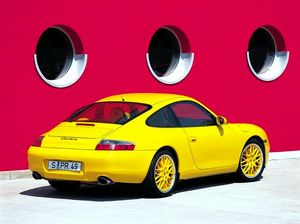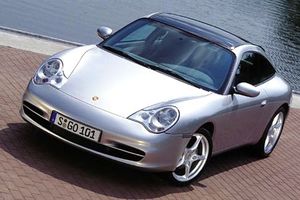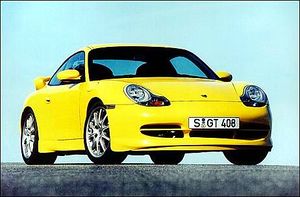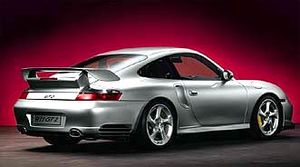.
Porsche 996

| |
| Porsche 996 | |
|---|---|
| Porsche | |
| aka | Porsche 911 Carrera |
| Production | 1996-2005 |
| Class | Sports Luxury |
| Body Style | Coupe/Cabriolet/Targa |
| Length | 4430 mm |
| Width | 1765 mm |
| Height | |
| Wheelbase | 2350 mm |
| Weight | Carrera 2 - 1345 KG Targa - 1415 KG Turbo - 1540 KG GT3 - 1380 KG GT2 - 1440 KG |
| Transmission | 6-speed manual 5-speed Tiptronic |
| Engine | 3.4 litre flat six 3.6 litre flat six 3.6 litre flat six, turbocharged |
| Power | 300 BHP 450 BHP (Turbo) |
| Similar | Ferrari 360 Modena Aston Martin V8 Vantage Mercedes-Benz SL500 |
| Designer | Pinky Lai under Harm Lagaay |
The Porsche 996 is the 4th generation of the Porsche 911 range. It was manufactured by Porsche between 1996 - 2005. It is significant in the the history of the 911 as it is the first 911 to break from several of the historic model's traditions, such as featuring organic ovoid headlights in place of the 911's traditional ovals and, more significantly, switching to a water-based cooling system in place of the 911's traditional air-cooled setup. It has also been criticized for being 'bloated' as it increases significantly in size compared to previous generations.
Task: To Perfect Perfection
The 996 model was given an un-enviable task - to replace the legendary, and very popular, 993 model, and also to carry the Porsche company into record profits and the new Millenium. The new model was redesigned from the ground-up from its predecessors, and featured a new chassis, transmission, engine and bodywork. The engine had decreased in capacity, to 3.4 litres, and was water-cooled, for the first time in a Porsche flat-six. Porsche cited ever-stringent emission and noise regulations for the swap in cooling - but Porsche enthusiasts moaned that the distinctive sound would be lost. But they hadn't heard it yet.
The engine was not the only point for criticism for the new 996, however. The general press and public pointed out that the front end was identical to its smaller sibling - the Boxster, a car almost half the price of the 911. But Porsche was eager to get people to see behind these 'faults', and embrace the radically different but comfortably similar new incarnation of the world's most famous sportscar.
Ground-up Re-engineering
The 993 could never be described as aging, but its Achilles' heel was the power plant, which was rooted in the past, and although Porsche had bought the engine some time from the strict worldwide emissions regulations and drive-by noise limitations with the excellent VarioCam system, the writing was on the wall, and the decision was taken to produce a whole new 911 which could conceivably carry the company well into the 2000s - and for this to happen, a new engine had to be built.
The flat-six Boxer configuration was retained, and air-cooling was scrapped, to make way for the water-cooling system, which was both more efficient and crucially, quieter. Capacity shrunk 200 cubic centimetres to 3.4 litres, but power was up overall to 300 BHP. But the engine was only part of the story.
The exterior design was penned by Pinky Lai, and was refreshingly contemporary over the 993. The front lights and driving lights of the 993 were incorporated into one pod, christened the 'Fried Egg' by its detractors. The evocative roofline remained, and the rear lost the reflector stripe under the bonnet - which was now lined by two larger units, incorporating all the necessary accoutrements. The doorhandles were now flush to the bodywork, and the doors were rimless, and to complement the changes, a whole new range of alloy wheels were designed, proving to be evolutions of their 993 predecessors.
The radical developments continued indoors. The traditional 'five dial' dash was ditched, and replaced with a more modern, smoother dashboard. The seat design was revised, and the cabin as a whole was larger and better equipped - a whole host of new electrical toys were made available for the 996 that space did not allow in the 993. A new colour chart and interior material list was drawn up, and the 996 featured leather seats as standard.
Under the skin, the power was delivered to the road by the now-traditional Carrera two wheel-drive and Carrera 4 four wheel-drive platforms, intercepted by a six-speed manual or revised five-speed Tiptronic semi-automatic gearbox.
The standard Carrera models were joined in 2000 by a Carrera-based 'Millenium' model, finished in Vesuvius Metallic with chromed 'Turbo Technic' alloys. Only 911 were built worldwide. In 2002, the whole range was updated, featuring new bumpers, alloy wheels, front lights, colour charts and equipment levels. The power went up slightly, as the bored-out 3.6 litre engine made its debut. To celebrate 40 Years of 911, in 2004 a special Celebration model was produced - again with a production run of only 1963 units worldwide - and featured the Aerokit as standard, the GT Silver paint from the Carrera GT, and boosted interior specifications. This model was the only 911 since the 1980s to actually be badged so - a special rear badge was designed, which was essentially '911' in an italicised script.
In conjunction with the 2002 revamp, the Targa model was unveiled - and was essentially a Carrera or Carrera 4 with the sliding glass roof as premiered on the 993 model almost a decade earlier. The new car was designed with a rear hatch window, making it the most practical sports car on the market. Again, the Targa was engineered by using a Cabriolet bodyshell as a base, then adding strong visual bars to top off the doors. From a side profile, the Targa has a sharper angle to the rear window over the standard Coupe.
Moving Upwards - the Super-996s
The Turbo
The obligatory Turbo model raced onto the price lists in 1999, boasting headline-grabbing performance figures such as 420BHP - from a twin-KKK-turbocharged 3.6 litre - and a sub four second 0-60mph time. The Turbo lines transferred well to the 996 shape - but the general opinion was that the car had lost a little visual drama over the outgoing 993. The 'Tea Tray' spoiler, once the trademark of the Turbo model, was dead, replaced by an almost-ducktail speed-operated, electrically-lifting example. The once-expansively wide rear arches were not as pronounced, but the impressive alloy wheels were retained, albeit in a modernised form.
But Porsche let the chassis and powerplant forge an impression of the car, and period press struggled for enough superlatives to describe the other-worldly performance, exploitable chassis and almost-impossible-with-such-performance everyday usability. Porsche had certainly produced a stunning automobile with the 996 Turbo, and strong sales reflected this. Technology was a trademark of the model, with such aerodynamic wonders like the rear-bumper air vents - which created a vacuum behind the car, sucking hot air from the engine. The carbon-composite brakes made their debut on the model - badged PCCB, and developed from Porsche's recent Le Mans activities, these amazing brakes promised fade-free performance. However, they carried a price tag to match - around £8,000!
The Turbo also filled the 'Luxury' part of its class tag. The interior was the first word in leather-lined opulence, with electric everything, and generous standard equipment levels.
Also available on the Turbo was the X50 option - the power kit. This harnessed better breathing and engine mapping to release an extra 30BHP, producing a peak 450BHP. Torque figures almost mirrored this. With the X50 option, the 996 Turbo was peerless in every respect.
From 2005, the Turbo S model was available, essentially as a run-out model. The car carried a price premium over the standard model, but featured the X50 option, Graphite-painted alloys, a special 'Olive Green' paint option and the Porsche Carbon Composite Brakes (PCCB) as standard. Equipment levels were high, and a limited slip differential was also added to the standard specification sheet.
===The GT3===
The GT3, released in 1998, was essentially the Carrera RS-equivalent for the 996 generation. However, the GT3 was a much more advanced engineering proposition compared to the standard RS ethos of weight reduction and sports suspension. The GT3 used a completely different engine to the standard Carrera, whose basic bodyshell it used. The engine was derived from the Le Mans winning 996 GT1, and featured lavish use of light and expensive materials - such as magnesium and titanium. The whole engine and the car was partly hand-built by Porsche's Motorsport Division, in Weissach.
Over the standard car, the GT3 had fully adjustable suspension which was set 40mm lower than the Carrera's. Anti-roll bars were fitted front and rear, and the interior was stripped in keeping with the idea that many customers would use the car for the new phenomenon - track days. The rear seats were jettisoned, along with the air conditioning and stereo, and bucket seats and a roll cage were added. However, due to an additional radiator, stronger gearbox and the more sophisticated engine, the GT3 weighed 40KG more than the Carrera. The Comfort model reinstated the air conditioning (if so specified), removed the roll cage (although the car was welded for it if the owner wanted to fit it eventually), included less severe perches and thicker carpeting. It was still a very extreme automobile. Exterior-wise, the GT3 was supplied with the 'Aerokit GT3', which included a rather handsome adjustable folded rear wing, in conjunction with deeper side skirts and a lip spoiler under the bumper. 'Sport Design' alloy wheels were fitted as standard, and were of two piece manufacture to keep unsprung mass to a minimum.
Although a success, the GT3 was updated along with the rest of the range in 2003, and now sported the new headlights and bumpers. A new rear spoiler was also specified, to provide greater downforce for extreme track work, and the handsome Sport Design alloys were replaced with a forged one-piece design. The ethos remained the same, and power was up to 381BHP. PCCB was available for track day fanatics looking for that extra edge, although horror stories circulated about cracking and disintegration of the brake discs themselves - Porsche denied this to be possible and also the warranty claims, meaning the unlucky owners had to fork out for new brakes - a very expensive proposition.
In 2003, the GT3 became even more extreme, with the GT3-RS. This model became the only RS-badged 996. Power remained the same over the GT3 Mk. 2, but 20KG of weight was lost, with further stripping from the interior, the addition of PCCB as standard, a carbon fibre rear spoiler, a carbon fibre bonnet and a plastic rear window. All GT3-RSs were supplied in White, and the owner could choose the colour of the alloy wheel centres and the script along the sills of the car - in either blue or red, designed to echo the 1972 2.7 Carrera RS. The GT3-RS has become a cult 911.
The GT2
The 993 GT2 was one of the wildest 911s available, and it came as a shock to the world when Porsche announced that it would create another, using the 996 as a base.
Released in 2001, the GT2 again used the Turbo model as a base, and removed the front differential, to create two-wheel drive. The power of the turbocharged powerplant was raised to 482 BHP, and unnecessary ancillaries such as traction control were removed. The interior went on a diet, and the suspension was lowered slightly. PCCB was added as standard, along with a more extreme bodykit - deeper front bumpers, thicker sideskirts and a larger rear wing over the Turbo.
The model was created to top off the 996 range, and to show all detractors that the 996 was, in fact, a performance car. This impression was cemented when the GT2 broke the production car lap record and the Nurburgring Nordschliefe in Germany.
See Also



